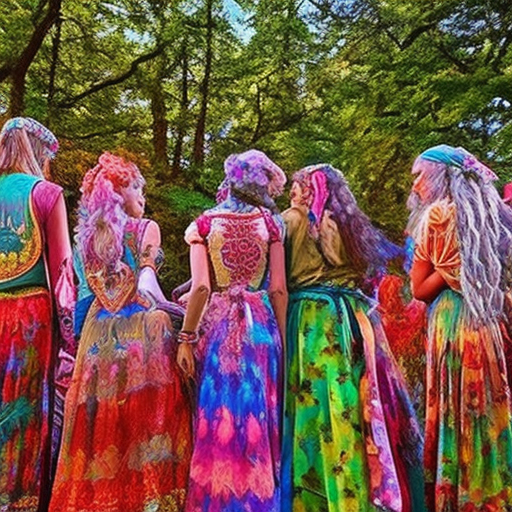Hippie Fashion: Embracing Freedom and Individuality
Hippie fashion emerged in the 1960s as a countercultural movement that rejected mainstream societal norms and embraced peace, love, and individuality. It was characterized by a unique style that reflected the values and ideals of the hippie subculture.
The Influence of the Hippie Movement
The hippie movement was a reaction to the political and social unrest of the time, including the Vietnam War and civil rights struggles. Hippies sought to create a more peaceful and egalitarian society, and their fashion choices reflected this desire for change.
Key Elements of Hippie Fashion
1. Bohemian Influence: Hippie fashion drew inspiration from bohemian and folk styles, incorporating loose-fitting garments, flowing fabrics, and ethnic prints. This reflected the desire for a more natural and free-spirited lifestyle.
2. Flower Power: The use of floral patterns and motifs was a prominent feature of hippie fashion. Flower crowns, embroidered flowers, and floral prints were popular, symbolizing peace, love, and connection with nature.
3. Denim: Denim became a staple of hippie fashion, representing rebellion and nonconformity. Bell-bottom jeans, denim jackets, and overalls were commonly worn, often adorned with patches, embroidery, or tie-dye.
4. Tie-Dye: Tie-dye was a popular technique used to create vibrant and psychedelic patterns on clothing. This DIY approach allowed individuals to express their creativity and reject mass-produced fashion.
5. Fringe and Leather: Fringed vests, jackets, and accessories were commonly worn by hippies, adding a bohemian and Western touch to their outfits. Leather, often in the form of sandals, bags, or belts, was also embraced for its natural and earthy appeal.
6. Layering: Layering was a key aspect of hippie fashion, allowing for individual expression and the mixing of different styles. Flowing maxi dresses, peasant blouses, and loose-fitting tunics were often paired with vests, scarves, and ponchos.
7. Accessories: Hippies adorned themselves with an array of accessories, including headbands, beaded necklaces, peace sign pendants, and oversized sunglasses. These accessories were often handmade or sourced from global cultures, reflecting a desire for cultural exchange and unity.
The Legacy of Hippie Fashion
Hippie fashion had a lasting impact on the fashion industry and continues to influence contemporary style. Its emphasis on individuality, self-expression, and sustainability resonates with modern consumers.
1. Boho Chic: The bohemian aesthetic, which originated from hippie fashion, remains popular today. Flowing maxi dresses, fringe details, and ethnic prints are often seen in boho-inspired collections.
2. DIY and Upcycling: The DIY ethos of hippie fashion has influenced the rise of sustainable fashion practices. Upcycling, where old garments are transformed into new pieces, has gained popularity as a way to reduce waste and promote individuality.
3. Peace and Love: The peace symbol, a prominent feature of hippie fashion, continues to be a powerful symbol of peace and unity. It is often incorporated into contemporary designs as a reminder of the values espoused by the hippie movement.
4. Gender-Neutral Fashion: The androgynous style embraced by hippies challenged traditional gender norms. This influence can be seen in contemporary fashion, with gender-neutral clothing becoming more prevalent and accepted.
5. Festival Fashion: The laid-back and free-spirited style of hippie fashion has become synonymous with music festivals. Festival-goers often embrace bohemian-inspired outfits, incorporating elements such as floral prints, fringe, and tie-dye.
In conclusion, hippie fashion emerged as a symbol of rebellion, peace, and individuality during the 1960s. It incorporated elements of bohemian and folk styles, with a focus on natural fabrics, ethnic prints, and DIY techniques. The legacy of hippie fashion can be seen in contemporary fashion trends, such as boho chic, sustainable practices, and gender-neutral clothing. Hippie fashion continues to inspire individuals to embrace their unique style and express themselves freely.












